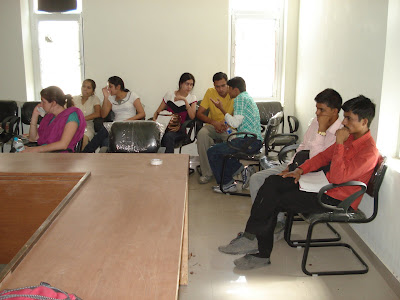








 "An Evening dedicated to Jewish-Muslim Relations in Memory of Daniel Pearl" was organised by Open Space - Lucknow on Saturday, 27th June, 2009, (the event also commemorated the publication of the Yiddish newspaper Die Yidishe Velt, which began publication in New York on 27th June, 1902) at the Academy of Mass Communication, Lucknow, among Muslim youth. On the occassion Brad Pitt produced film A Mighty Heart (2007), based on Pearl's widow Mariane's memoir, A Mighty Heart - The Brave Life and Death of My Husband Danny Pearl, was screened, and a bilingual publication (English and Urdu) of the Centre for Interfaith Studies, Faislabad, Pakistan, was distributed among the audience, who took part in a lively discussion after the screening. American Jewish journalist Daniel Pearl, who served as the South Asia Bureau Chief of the Wall Street Journal, was kidnapped and beheaded in Karachi in 2002. The killing of Pearl led his parents, Professor Judea Pearl and Ruth Pearl, to establish an organisation in his memory, the Daniel Pearl Foundation, dedicated to world peace and to the beterment of Jewish-Muslim relations. Below is the message from Daniel's parents, received on the ocassion of this event:
"An Evening dedicated to Jewish-Muslim Relations in Memory of Daniel Pearl" was organised by Open Space - Lucknow on Saturday, 27th June, 2009, (the event also commemorated the publication of the Yiddish newspaper Die Yidishe Velt, which began publication in New York on 27th June, 1902) at the Academy of Mass Communication, Lucknow, among Muslim youth. On the occassion Brad Pitt produced film A Mighty Heart (2007), based on Pearl's widow Mariane's memoir, A Mighty Heart - The Brave Life and Death of My Husband Danny Pearl, was screened, and a bilingual publication (English and Urdu) of the Centre for Interfaith Studies, Faislabad, Pakistan, was distributed among the audience, who took part in a lively discussion after the screening. American Jewish journalist Daniel Pearl, who served as the South Asia Bureau Chief of the Wall Street Journal, was kidnapped and beheaded in Karachi in 2002. The killing of Pearl led his parents, Professor Judea Pearl and Ruth Pearl, to establish an organisation in his memory, the Daniel Pearl Foundation, dedicated to world peace and to the beterment of Jewish-Muslim relations. Below is the message from Daniel's parents, received on the ocassion of this event:
Mrs. Ruth Pearl and Professor Judea Pearl, parents of Daniel Pearl (courtesy: Daily Life)
On behalf of the family of Daniel Pearl we would like to express our gratitude to Navras Jaat Aafreedi and the organizer of this event, for honouring our son Daniel by dedicating this evening in his memory.It has been heart-warming for us to see people from all walks of life reaffirming their commitments to the ideals for which Danny stood: truth, fairness and respect for all people.But it is especially significant for us, and for Danny's son, Adam, to see Danny's legacy supported by people from the Muslim religion, the religion of the country where Danny's journey came to a sudden halt.We live in an era where hate propagates with Internet speeds, and one can easily get the impression that humanity is losing ground to a rising tide of savagery. Adam's generation must understand that this is a misleading metaphor; that underneath the surface we have an ocean of decency and goodwill, and that hatred and ignorance are merely islands that can be conquered.We witnessed this undercurrent of decency when so many Muslims offered us help and sympathy when Danny's death was made public.We witnessed this undercurrent of decency throughout our journey with Professor Akbar Ahmad along the Daniel Pearl Muslim-Jewish dialogue trail.We witnessed this undercurrent of decency when we celebrated Danny's would-be 45th birthday, on October 10, 2008. 1,100 concerts in 60 countries participated in this global event, including dozens of groups from Muslim countries, all united by the ideals for which Danny's stood, and all taking a stand for tolerance and humanity.And we are witnessing this undercurrent here, tonight, through your inititative to establish this evening of Jewish-Muslim relations in Memory of Daniel Pearl.We know that the people who attend this evening will continue Danny's quest for truth and understanding, and will venture to eradicate the ignorance and hatred that took Danny's life.Thank you all for helping us uncover and activate this ocean of decency for Adam's generation.Salam Aleikum!Shalom Aleichem!
- Judea and Ruth Pearl
Los Angeles, California
Reports on the event can be read on the following websites:
The Times of India
Daniel Pearl Foundation
Reports on the event can be read on the following websites:
The Times of India
Daniel Pearl Foundation












































